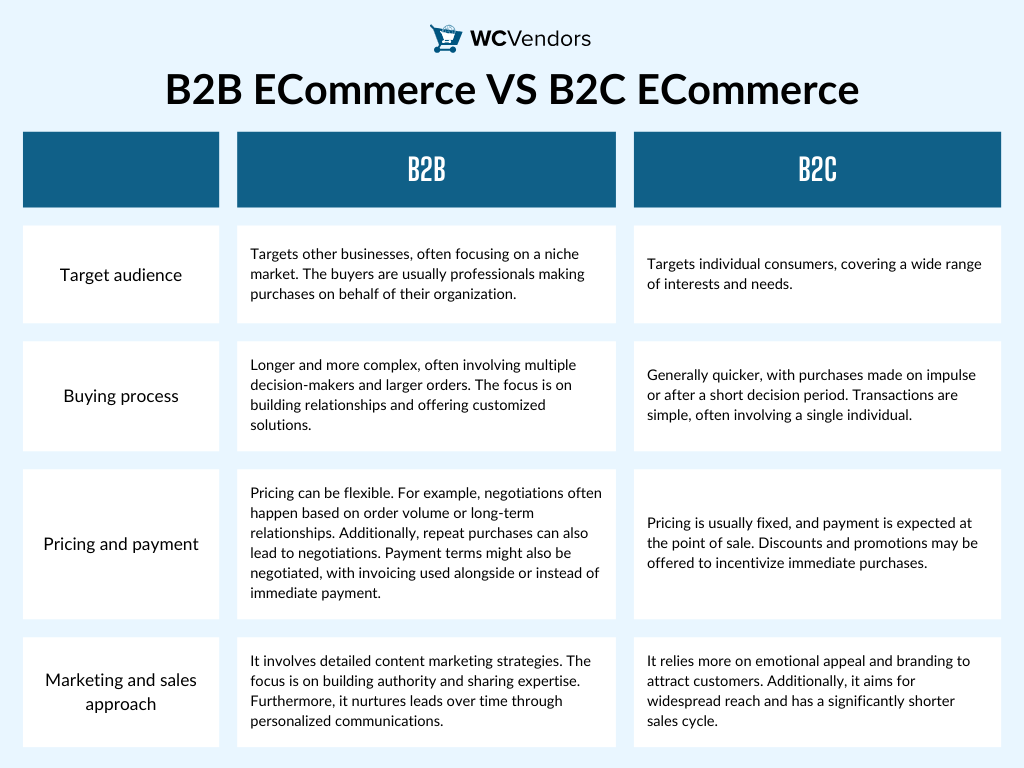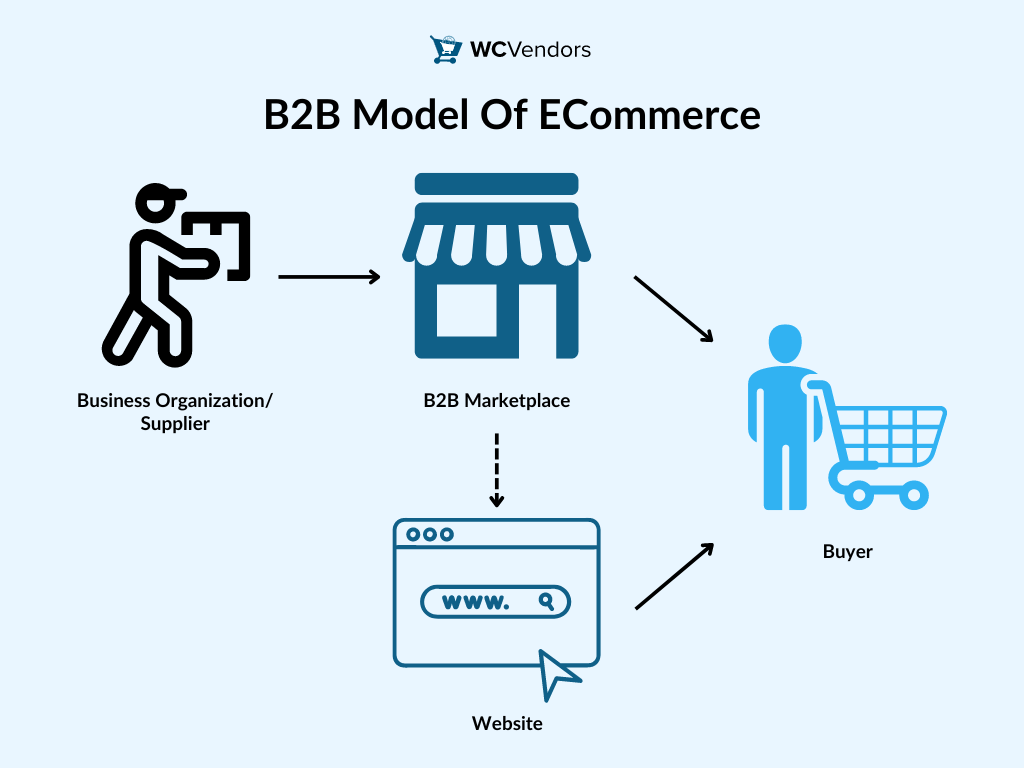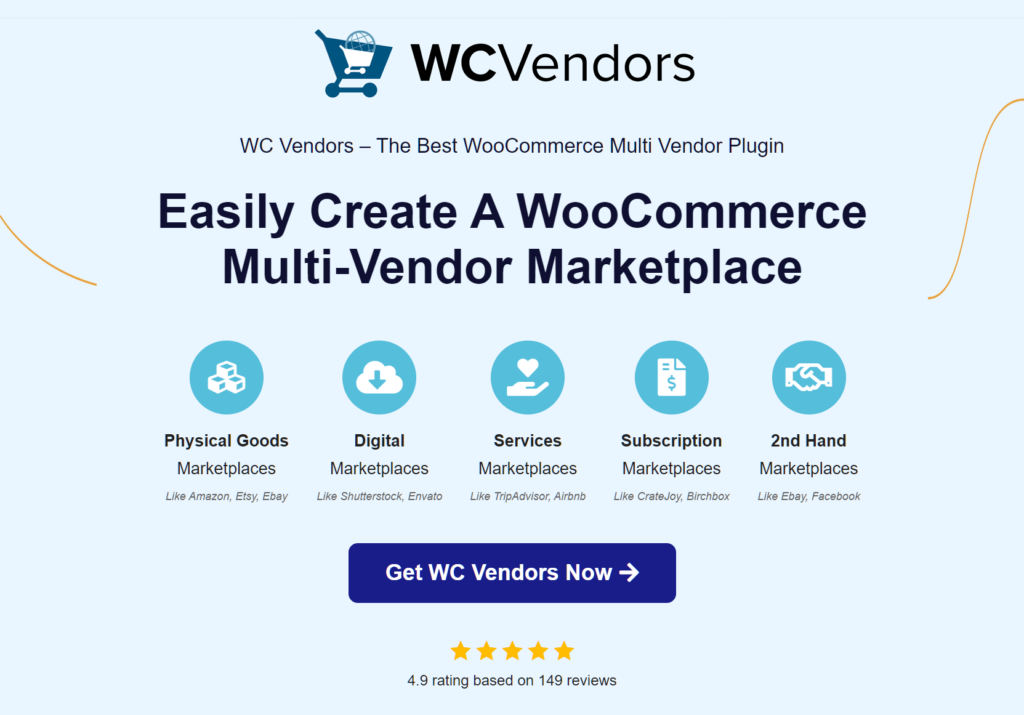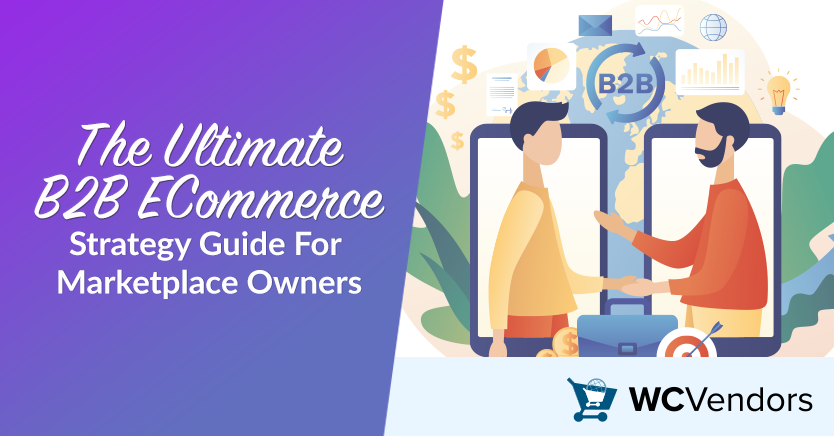
Do you have a B2B eCommerce strategy in place for your online marketplace? Given that more businesses are heading online, it’s critical for marketplace owners to establish a strong strategy.
This guide will give you practical tips and smart strategies to improve your marketplace and boost your sales. Basically, we’ll help you really get to know your customers and show you how to use the best tech tools. This way, you’ll learn everything important to make better choices and improve how you show up online.
So, let’s get started!
Understanding B2B ECommerce
B2B eCommerce is when businesses sell goods or services to other businesses online. It does not involve selling directly to individual customers (B2C). It’s common in industries that need specific items or materials to make their products.
In the B2B world, selling online isn’t just about making sales. It’s a smart way to do business. It makes buying and selling easier. Additionally, it improves customer support and provides tailored experiences for professional buyers. The aim is to make sure buying is easy and efficient.
Comparing B2B And B2C ECommerce
Target audience
- B2B: Targets other businesses, often focusing on a niche market. Typically, the buyers are professionals making purchases on behalf of their organization.
- B2C: Targets individual consumers, covering a wide range of interests and needs.
Buying process
- B2B: Longer and more complex, often involving multiple decision-makers and larger orders. The focus is on building relationships and offering customized solutions.
- B2C: Generally quicker, with purchases made on impulse or after a short decision period. Transactions are simple, often involving a single individual.
Pricing and payment
- B2B: Pricing can be flexible. For example, negotiations often happen based on order volume or long-term relationships. Additionally, repeat purchases can also lead to negotiations. Payment terms might also be negotiated, with invoicing used alongside or instead of immediate payment.
- B2C: Pricing is usually fixed, and payment is expected at the point of sale. Discounts and promotions may be offered to incentivize immediate purchases.
Marketing and sales approach
- B2B: It involves detailed content marketing strategies. The focus is on building authority and sharing expertise. Furthermore, it nurtures leads over time through personalized communications.
- B2C: It relies more on emotional appeal and branding to attract customers. Additionally, it aims for widespread reach and has a significantly shorter sales cycle.
Knowing these differences is key for businesses aiming to succeed online. Each method needs its own strategies to effectively reach customers and grow your business.
Now, let’s explore the B2B model of eCommerce in greater detail. Read on further!
What Is The B2B Model Of ECommerce?
The Business-to-Business (B2B) eCommerce model is about one company selling to another. It’s not for selling to everyday people. In this model, two companies—the supplier and the purchaser—work closely together. They really get to know each other’s business methods and build trust.
Moreover, they create custom solutions that fit smoothly into the buyer’s existing processes. These solutions integrate seamlessly into their workflows. In a B2B setup, the relationship and steady partnerships are just as important as the actual selling and buying of goods or services.
Key features of B2B ECommerce:
- Understanding business cycles: Understanding the buying and operational patterns of clients is key. It helps suppliers match their products with the clients’ needs. For instance, suppliers can cater to seasonal trends or regular large orders. This way, businesses stay in sync, ensuring a smooth supply when the client needs it most.
- Customized solutions: B2B platforms often need to offer more customization. This applies to their products or services. This ensures they fit seamlessly into the buyer’s operations without causing any problems.
- Trust and reliability: Building long-term relationships based on trust and consistent quality is crucial. It significantly boosts repeat business, which is a key aspect of the B2B model.
- Streamlined operations: Efficiently manage orders, billing, and shipping. Additionally, provide excellent customer service to meet clients’ business needs. This often involves integration into existing procurement and supply chain management systems.
Example: B2B online marketplace
Consider an online marketplace like Alibaba or Amazon Business, which stands as a towering example of B2B eCommerce in action. They serve as a bridge, connecting suppliers directly with businesses worldwide.
These platforms offer a wide variety of products. Businesses can purchase in large quantities or customize them to meet specific needs.
Scenario: A manufacturing company needs a lot of industrial-grade steel to make machinery. The company’s procurement manager searches for suppliers on a B2B marketplace. They look for those offering the right type of steel, with the necessary certifications, at competitive prices. Here’s how the platform helps:
- Compare suppliers: The manager can review different suppliers. This includes checking their reviews, certifications, and product quality.
- Negotiate terms: The manager can speak directly with suppliers to discuss prices. They can also talk about delivery times and payment methods.
- Place orders: The manager uses the platform to order the steel, state any specific requirements, and plan out the shipping details.
- Seamless integration: The chosen supplier coordinates with the company’s procurement system. This ensures the steel is delivered on time and properly managed in inventory.
B2B eCommerce platforms like Alibaba and Amazon Business simplify purchasing for companies. A good B2B eCommerce strategy makes buying steps easier and the supply chain clearer. It helps build strong global connections. Using these platforms, companies can find many suppliers, save money by buying in bulk, and customize orders to their needs. This flexibility often isn’t found in traditional business transactions.
What Are The Best Practices For B2B ECommerce Companies?
Starting a B2B eCommerce business is a big step. It can be really exciting, but also a bit overwhelming. These guidelines below are great for beginners looking to make a strong start. Moreover, they are valuable for those with experience who want to improve further.
Here’s a list of important best practices that work for all B2B eCommerce businesses:
- Enhanced user and mobile experience: Design your platform with a simple and easy-to-use interface. Also, make sure it’s optimized for mobile devices. This approach retains customers and facilitates sales across all devices.
- Personalized customer engagement: Utilize data analytics for personalized recommendations. Also, include rich product content with detailed descriptions, specs, and high-quality images. This boosts engagement and helps buyers make informed decisions.
- Efficient search and checkout: Combine robust search functionality with a simplified checkout process. A powerful search tool with filtering options reduces cart abandonment. Additionally, a streamlined checkout enhances the shopping experience.
- Versatile payments and comprehensive support: Offer a range of payment methods to meet varied business needs. Furthermore, provide comprehensive customer support through live chat, email, and phone lines. This promotes trust and accommodates different customer preferences.
- Automated order management and security: Implement automated systems for order tracking, inventory, and shipping. Additionally, make sure to prioritize the security of your platform and customer data. This ensures accuracy, timely delivery, and complies with regulations.
- Strategic marketing and communication: Use SEO strategies to boost your company’s visibility. Engaging content marketing can help establish your company as a thought leader. Clearly explain your pricing, policies, and value proposition. This helps build credibility and trust.
- Feedback and flexible shipping: Set up ways to gather customer feedback to drive continuous improvement. Furthermore, provide flexible shipping options to enhance the customer experience. This approach tailors services to customer needs and enhances overall satisfaction.
Applying best practices to your marketplace
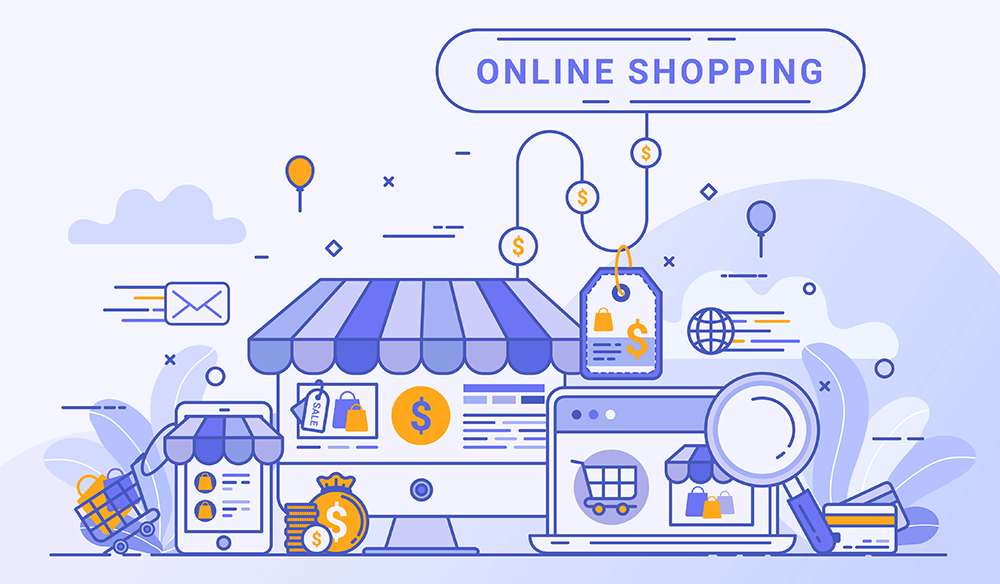
As you shift from a traditional setup to an online marketplace, start using new technology to enhance your operations. Analyze customer data to offer relevant deals and products. Ensure your website is mobile-friendly since more people use phones for business. This allows easy communication anytime, anywhere.
To build trust and community, communicate clearly and handle data and payments securely. Use forums or social media for customer interactions and feedback. By following these best practices, your marketplace will grow more quickly. Additionally, you’ll boost customer satisfaction and set a new standard in B2B eCommerce.
How To Market B2B ECommerce?
Marketing in the world of B2B eCommerce means finding smart ways to reach other businesses that might need what you’re selling. Basically, it’s all about understanding those businesses and sharing useful information. Additionally, use online tools to make connections.
Here are effective tips and tools to consider:

1. Understand your audience
Get to know your customers’ needs, challenges, and decision-making processes. Use surveys, interviews, and customer data analysis to gather insights.
2. Create and optimize valuable content
Create valuable content such as blogs, whitepapers, and videos. Focus on addressing your audience’s pain points and challenges. Use tools such as HubSpot and WordPress to manage your content effectively. Additionally, use keyword research tools like Google Keyword Planner and SEMrush to enhance your SEO. This will help you reach more people and provide them with the information they need.
Share your content on LinkedIn, Twitter, and Facebook to engage with your audience. Additionally, use personalized email campaigns to nurture leads. Tools like Mailchimp can help keep your audience engaged. Using both social media and email marketing helps your message reach a larger audience. This approach ensures your message is effective and widely seen.
4. Implement marketing automation
Automate repetitive tasks with tools like Marketo or HubSpot. This includes email campaigns, social media posting, and lead tracking. These tools help you save time and ensure your marketing efforts are consistent. Additionally, automation allows for more personalized and timely interactions with potential customers.
5. Utilize PPC advertising
Use pay-per-click (PPC) advertising on platforms like Google Ads and LinkedIn. This will help you target specific audiences and drive traffic to your site. Be strategic with your ad copy and targeting options.
6. Engage through webinars and partnerships
Host or participate in industry-relevant webinars using platforms like Zoom or GoToWebinar. Collaborate with complementary businesses or industry influencers. Furthermore, co-create content or co-host events to expand your reach and credibility.
7. Analyze and adjust
Regularly review analytics to understand what’s working and what’s not. Tools like Google Analytics and social media analytics offer valuable insights. They help you understand traffic, engagement, and conversion rates.
8. Use a good eCommerce platform base
Using WordPress and the WC Vendors plugin together makes a great starting point for creating a B2B eCommerce marketplace. This setup provides growth potential and easy customization.
Additionally, it includes many features to handle complex business deals. It fits perfectly with the specific needs of B2B sales. This ensures that both sellers and buyers have a smooth and effective experience.
Advanced features of WC Vendors:
- Vendor management: Simplifying the addition and oversight of multiple vendors.
- Custom commission rates: Flexibility in setting individual commission rates.
- Product management: Advanced options for detailed product listings and inventory control.
- Dashboard analytics: Insightful sales and behavior analytics for vendors and administrators.
- Access controls: Specific permissions and roles for vendors to maintain marketplace integrity.
- Integration capabilities: Compatibility with a broad array of WordPress plugins enhances functionality.
- Customizable storefronts: Allows vendors to personalize their shops to align with their branding.
With these tips and tools for marketing B2B eCommerce, you’re ready to connect and engage with your business audience.
To truly succeed in the B2B eCommerce landscape, understanding the critical success factors involved is key. What makes a B2B eCommerce operation thrive? Let’s explore the vital ingredients for success in the next section.
What Are The Success Factors Involved In B2B ECommerce?
Success in B2B eCommerce doesn’t happen by chance. It needs a combination of smart strategies and high-quality service. Plus, you must have the right technology to support it. Let’s explore the core factors that contribute to a thriving B2B eCommerce business:
1. Quality of product information
Clear and detailed product information is vital. Customers need to understand what they’re buying. This is especially true in B2B transactions, where products can be complex. High-quality images and detailed descriptions help a lot. Specifications, 3D models, and video demonstrations can also make a big difference.
2. User experience
A B2B eCommerce platform should offer an intuitive, user-friendly interface. Navigation should be simple and finding products must be straightforward. Remember, B2B buyers often require specific features like bulk ordering and quick reordering. These features should be seamlessly integrated into your platform.
3. Personalization
Not all businesses have the same needs. Personalization matters a lot. It’s about suggesting the right products, offering special pricing, and tailoring marketing messages. This builds stronger customer relationships. In turn, it leads to more loyalty and sales.
4. Customer service
Excellent customer service is non-negotiable. A B2B platform must provide various channels for support such as live chat, phone support, and email. Timely, helpful responses to inquiries and problems are crucial for long-term client retention.
5. Mobile optimization
With more people using mobile devices for work, a mobile-optimized website or app is essential. This ensures you stay competitive. A mobile-friendly platform should offer full functionality, even on smaller screens.
6. Pricing and payment options

Clear and fair pricing is key. Offering different ways to pay, like credit terms, also matters. This meets the various payment preferences of different groups.
7. Security and compliance
Following data protection standards is essential for building trust. Additionally, providing a secure online environment is crucial. Compliance with regulations such as GDPR also signals to your customers that you take their data seriously.
8. Efficient order processing and fulfillment
A reliable and efficient order fulfillment process is crucial. Clear communication about shipping times and tracking helps build trust. Additionally, clear return policies encourage repeat business.
9. Integration capabilities
The B2B eCommerce platform should integrate well with systems such as CRM and ERP. This makes operations smoother and improves data management.
10. Analytics and feedback
Leveraging data analytics tools helps understand customer behavior and decision-making patterns. This knowledge can drive strategic improvements. Additionally, actively seeking and acting upon customer feedback shows commitment to continuous enhancement.
Conclusion
To craft a successful B2B eCommerce strategy, it’s crucial to integrate the insights and practices we’ve discussed. By understanding B2B transactions, you can improve your online marketplace. This will help you optimize your platform more effectively. Additionally, leveraging the right tools and strategies will enhance your business operations.
To help you with your B2B eCommerce strategy, here’s what you need to focus on:
- Understanding B2B ECommerce
- Differences of B2B and B2C ECommerce
- B2B Model of ECommerce
- Best Practices for B2B ECommerce Companies
- Marketing B2B ECommerce
- Success Factors Involved in B2B ECommerce
By focusing on these areas, you can build a strong foundation for your B2B eCommerce strategy. Consequently, you’ll be well-positioned to achieve greater success in the online marketplace. If you need further guidance or have any questions, feel free to reach out – we’re here to support you every step of the way!
